
A Mii is a customizable avatar used on several Nintendo video game consoles and mobile apps. The name Mii is a portmanteau of "Wii" and "me", referring to them typically being avatars of the players. Miis were first introduced on the Wii console in 2006 and later appeared on the DS, 3DS, the Wii U, the Switch, and various apps for smart devices such as Miitomo. Miis can be created using different body, facial and clothing features, and can then be used as characters within games on the consoles, either as an avatar of a specific player or in some games portrayed as characters with their own personalities. Miis can be shared and transferred between consoles, either manually or automatically with other users over the internet and local wireless communications.
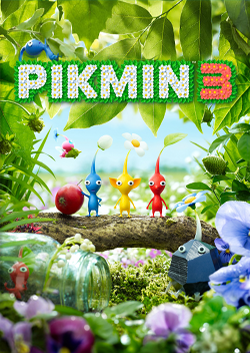
Pikmin 3 is a 2013 real-time strategy and puzzle video game developed and published by Nintendo for the Wii U video game console. It is the sequel to the GameCube games Pikmin (2001) and Pikmin 2 (2004), and was released in Japan on July 13, 2013, and in all other regions the next month. Shigeru Miyamoto announced Pikmin 3 on July 16, 2008, for the Wii console, later stating at E3 2011 that it had transitioned to the Wii U.
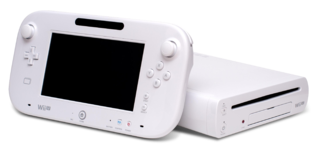
The Wii U is a home video game console developed by Nintendo as the successor to the Wii. Released in late 2012, it is the first eighth-generation video game console and competed with Microsoft's Xbox One and Sony's PlayStation 4.
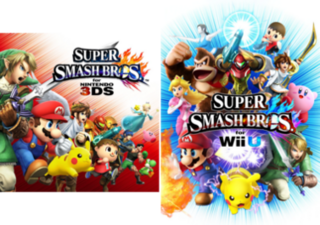
Super Smash Bros. for Nintendo 3DS and Super Smash Bros. for Wii U are 2014 crossover platform fighter video games developed by Bandai Namco Studios and Sora Ltd. and published by Nintendo for the Nintendo 3DS and Wii U video game consoles. It is the fourth installment in the Super Smash Bros. series, succeeding Super Smash Bros. Brawl. The Nintendo 3DS version was released in Japan on September 13, 2014, and in North America, Europe, and Australia the following month. The Wii U version was released in North America, Europe, and Australia in November 2014 and in Japan the following month.

New Super Mario Bros. U is a platform video game developed and published by Nintendo. It was originally released in 2012 as a launch game for the Wii U. It is the fourth and final entry in the New Super Mario Bros. series, and is the first Super Mario game to be released in high-definition graphics. The game is a sequel to New Super Mario Bros. Wii (2009) and a follow-up to New Super Mario Bros. 2 (2012).

The Legend of Zelda: Breath of the Wild is a 2017 action-adventure game developed and published by Nintendo for the Nintendo Switch and Wii U. Set at the end of the Zelda timeline, the player controls an amnesiac Link as he sets out to save Princess Zelda and prevent Calamity Ganon from destroying the world. Players explore the open world of Hyrule while they collect items and complete objectives such as puzzles or side quests. Breath of the Wild's world is unstructured and encourages exploration and experimentation; the story can be completed in a nonlinear fashion.

Pushmo, known as Pullblox in Europe and Australia and Hikuosu in Japan, is a downloadable puzzle game developed by Intelligent Systems and published by Nintendo for its Nintendo 3DS handheld system, available on the Nintendo eShop. In the game, players must shift around puzzle blocks in order to create steps and platforms, ultimately to reach children who have been trapped within the giant structures. A sequel, Crashmo, was released for the Nintendo 3DS in 2012. A third game, Pushmo World, was released for Wii U on June 19, 2014. A fourth game, Stretchmo, was released for Nintendo 3DS in May 2015.
The Nintendo Network is Nintendo's online service which provides online functionality for the Nintendo 3DS and Wii U systems and their compatible games. Announced on January 26, 2012, at an investors' conference, it is Nintendo's second online service after Nintendo Wi-Fi Connection. Former president of Nintendo Satoru Iwata said, "Unlike Nintendo Wi-Fi Connection, which has been focused upon specific functionalities and concepts, we are aiming to establish a platform where various services available through the network for our consumers shall be connected via Nintendo Network service so that the company can make comprehensive proposals to consumers."

Miiverse was a social network for Nintendo 3DS and Wii U, created by Nintendo System Development and Hatena, and powered by the Nintendo Network. Integrated into many games, Miiverse allowed players to interact and share their experiences by way of handwritten messages or drawings, text, screenshots, and sometimes game videos in dedicated communities. It was available via any web browser, and a dedicated app version originally planned for tablets and smartphones. All users who signed up for a Nintendo Network ID were automatically given a Miiverse profile per account, represented by the Mii avatar connected to said Nintendo Network ID.
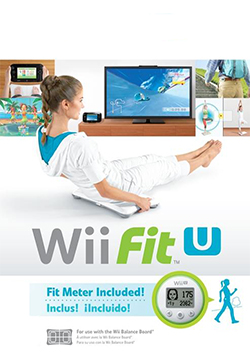
Wii Fit U is an exergaming video game developed by Nintendo for the Wii U console, and is the successor to the Wii games Wii Fit and Wii Fit Plus. Wii Fit U utilizes both the Wii Balance Board and the Wii U GamePad in gameplay, and is bundled with the newly introduced Fit Meter, an activity meter accessory. It was released in Japan on October 31, 2013, followed by North America and Europe one day later. It is also the only game on the system to support the balance board.

The Wii U system software is the official firmware version and operating system for Nintendo's Wii U home video game console. Nintendo maintains the Wii U's systemwide features and applications by offering system software updates via the Internet. Updates are optional to each console owner, but may be required in order to retain interoperability with Nintendo's online services. Each update is cumulative, including all changes from previous updates.

Crashmo, known as Fallblox in Europe and Australia and as Hiku Otsu in Japan, is a puzzle video game developed by Intelligent Systems and published by Nintendo for the Nintendo 3DS via the Nintendo eShop. The game is a sequel to Pushmo and was released in Japan on October 31, 2012, in the PAL regions on November 15, 2012, and in North America on November 22, 2012.
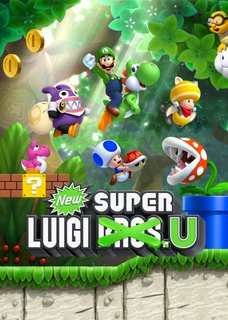
New Super Luigi U is a 2013 platform game developed by Nintendo for the Wii U. It is an expansion pack for New Super Mario Bros. U (2012), part of the Super Mario series. The plot and game mechanics remain identical to New Super Mario Bros. U, but Luigi replaces Mario as the protagonist. Luigi jumps higher and has less ground friction than Mario, and every level is redesigned to increase the difficulty level. The expansion adds Nabbit, a non-player character from New Super Mario Bros. U, as an invincible playable character.

The Year of Luigi was the 30th-anniversary celebration of the fictional character Luigi. He was created by Japanese video game designer Shigeru Miyamoto for the 1983 arcade game Mario Bros. and has appeared frequently as a minor or supporting character in the Mario franchise since. Due to Nintendo's decision to develop Luigi's Mansion: Dark Moon and Mario & Luigi: Dream Team at the same time, they declared 2013 the Year of Luigi. According to Mario creator Shigeru Miyamoto, Nintendo staff members also had the urge to develop games focused on Luigi, and considered the character underrepresented compared to Mario. It was announced via Nintendo Direct on February 14, 2013, by Nintendo CEO Satoru Iwata and ended on March 18, 2014.

Animal Crossing Plaza was a discontinued free to play social networking service developed and published by Nintendo for the Wii U. A spin-off of Animal Crossing: New Leaf of the Animal Crossing series, Plaza was released as a tie-in to Miiverse, Nintendo's now-defunct social networking service. The application is no longer actively supported by Nintendo, and was removed from the Nintendo eShop on December 22, 2014.
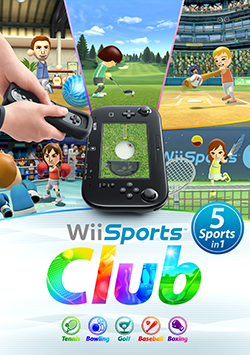
Wii Sports Club is a sports simulation video game, developed by Nintendo and Bandai Namco Studios and published by Nintendo for the Wii U throughout 2013 and 2014. It is the third entry in the Wii Sports series, a part of the larger Wii series. As an enhanced remake of the 2006 Wii launch title Wii Sports, it includes five minigames that replicate Tennis, Baseball, Bowling, Golf, and Boxing, and are controlled with motion controls that replicate the sports. New to the game is additional control schemes using the Wii U GamePad, online multiplayer, and Wii Motion Plus support. Players are organized into clubs that represent different regions, and scores and stats are tracked on Nintendo's social network Miiverse. Players could also communicate with each other during and after online matches using Miiverse. Each sport can be purchased individually or rented for a certain amount of time via a pass.
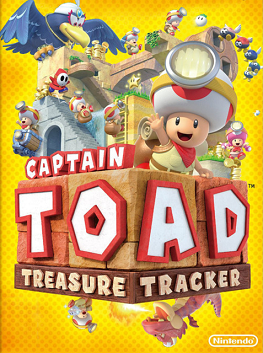
Captain Toad: Treasure Tracker is a 2014 action puzzle video game developed and published by Nintendo for the Wii U. The game was re-released for the Nintendo Switch and Nintendo 3DS in 2018 with additional content. It is a spin-off of the Super Mario series and a part of the larger Mario franchise. The game stars Captain Toad and Toadette as they complete levels and save each other from the antagonist Wingo. Each level is contained within a miniature diorama-like environment that requires puzzle-solving and platforming challenges to complete. The player also uses the Wii U GamePad to rotate the camera and reveal new information and interact with the environment.
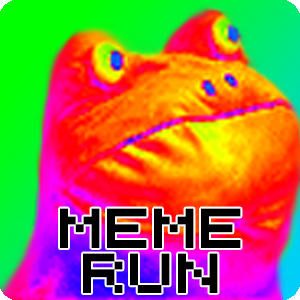
Meme Run is an endless running video game created by American indie developer Ninja Pig Studios for the Wii U console's eShop service. The game features extensive use of Internet memes; for example, the player character is a stick figure with a trollface for a head, and the levels are made up of Lenny faces. The game was designed to appeal to both hardcore and casual audiences, but has been widely criticized both before and after its release for its perceived low quality.

Mario vs. Donkey Kong: Tipping Stars is a puzzle video game developed by Nintendo Software Technology and published by Nintendo for the Nintendo 3DS and Wii U. It is the sixth game in the Mario vs. Donkey Kong series, succeeding Mini-Land Mayhem and Minis on the Move, and the 200th ever video game featuring Mario. The title was released worldwide in March 2015 on the Nintendo eShop for all regions, except in Japan. This is the first Nintendo-published title to support a cross-purchase concept, and the first Nintendo 3DS title to support Miiverse stamps. If players buy one version, they receive a free download code for the other version.

Stretchmo, known as Fullblox in Europe and Australia and as Hikudasu Hippaland in Japan, is a downloadable puzzle game developed by Intelligent Systems and published by Nintendo for its Nintendo 3DS handheld system. The game is a sequel to Pushmo, Crashmo, and Pushmo World and was released on the Nintendo eShop.

















